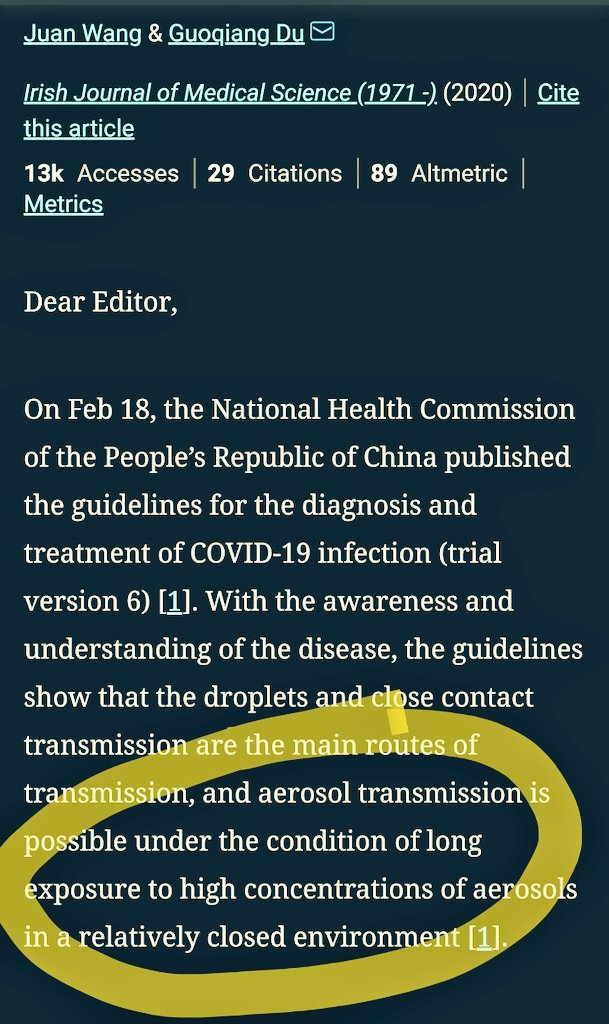In case there& #39;s doubt that the virus can spread through respiratory particles that float in air and travel far, I wanted to share these studies:
1. Indoor airborne event: plant worker transmits virus to those 24ft away in area w/re-circulated air 1/n
https://papers.ssrn.com/sol3/papers.cfm?abstract_id=3654517">https://papers.ssrn.com/sol3/pape...
1. Indoor airborne event: plant worker transmits virus to those 24ft away in area w/re-circulated air 1/n
https://papers.ssrn.com/sol3/papers.cfm?abstract_id=3654517">https://papers.ssrn.com/sol3/pape...
2. Super-spreader at choir: of 27 participants, 70% diagnosed w/COVID-19; 36% hospitalized; 21% ICU.
It was indoors w/no ventilation. Spread was likely through both big droplets that fall to the ground & airborne aerosols that float 2/n https://www.medrxiv.org/content/10.1101/2020.07.19.20145326v2">https://www.medrxiv.org/content/1...
It was indoors w/no ventilation. Spread was likely through both big droplets that fall to the ground & airborne aerosols that float 2/n https://www.medrxiv.org/content/10.1101/2020.07.19.20145326v2">https://www.medrxiv.org/content/1...
3. JAMA: super-spreader infects 23 on bus: "Airborne spread of SARS-CoV-2 seems likely to have contributed to the high attack rate in the exposed bus" The AC unit was set to "re-circulation mode" 3/n https://jamanetwork.com/journals/jamainternalmedicine/fullarticle/2770172">https://jamanetwork.com/journals/...
4. CDC: Another choir super-spreading event: following practice, 32 confirmed; 20 probable secondary cases. "The act of singing, itself, might have contributed to transmission through emission of aerosols, which is affected by loudness of vocalization" 4/n https://www.cdc.gov/mmwr/volumes/69/wr/mm6919e6.htm">https://www.cdc.gov/mmwr/volu...
5. Coronavirus is in the air: 94 employees (out of 216) were infected in a call center in South Korea, a 43.5% attack rate! Nearly all of them sat on the same side of the building, suggesting airflow as culprit 5/n https://wwwnc.cdc.gov/eid/article/26/8/20-1274_article">https://wwwnc.cdc.gov/eid/artic...
6. Another study pointing to coronavirus in the air: an asymptomatic individual sitting at a table in a restaurant infected people sitting at two other tables that were facing an Air Conditioning unit, pointing to recirculated air as the culprit 6/n https://wwwnc.cdc.gov/eid/article/26/7/20-0764_article">https://wwwnc.cdc.gov/eid/artic...
7. NATURE: virus captured from aerosols: Aerosols emitted by SARS-CoV-2 patients contain the virus and the virus can infect cells 7/n https://www.nature.com/articles/s41598-020-69286-3">https://www.nature.com/articles/...
8. Another study shows viable SARS-CoV-2 captured from air samples, this time 2-5 meters away with COVID-19 patients. Virus is stable and in respiratory aerosols that can float far. 8/n https://www.medrxiv.org/content/10.1101/2020.08.03.20167395v1">https://www.medrxiv.org/content/1...
9. CDC: Virus is stable in air: once airborne, SARS-CoV-2 retains ability to infect for at least 16 hrs. It& #39;s hardier in aerosols than SARS-1 or MERS
This helps explain why airborne route could be major culprit 9/n https://wwwnc.cdc.gov/eid/article/26/9/20-1806_article">https://wwwnc.cdc.gov/eid/artic...
This helps explain why airborne route could be major culprit 9/n https://wwwnc.cdc.gov/eid/article/26/9/20-1806_article">https://wwwnc.cdc.gov/eid/artic...
10. Scientists have been saying this for a long time.
@DrLaPook to @kprather88:How sure are you that the virus is significantly spread through aerosolization? 10/n
@DrLaPook to @kprather88:How sure are you that the virus is significantly spread through aerosolization? 10/n

 Read on Twitter
Read on Twitter


